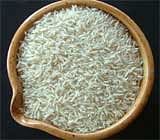Fragrance in rice originated in Japan, not India

But now the results of a study by a team of scientists from Cornell University in the US and International Rice Research Institute (IRRI) in the Philippines may dent this national pride.
The scientists say their research has reconfirmed the finding by previous workers that genetically, Basmati rice does not fall under Indica subgroup of rice varieties grown in southern Asia. It belongs to the Japonica subgroup, grown mostly in Japan.
More important, they claim to have shown for the first time that fragrance in rice originated within the Japonica group and the trait was then transferred to Indica rice by a natural process called "introgression".
Their results which challenge the traditional assumption that the fragrance trait arose in the Indica group have been published in the latest issue of the Proceedings of the National Academy of Sciences of the US.
Cultivated rice plant (Oryza sativa) consists of two subspecies, Japonica and Indica.
Japonica rice is round and sticky when cooked, while Indica rice has long grains that get fluffy on cooking.
Earlier genetic investigations had led scientists to establish that a gene called BADH2 is responsible for fragrance in rice. "The predominant allele or variant of this gene called badh2.1 is found in virtually all fragrant rice varieties today, including Basmati and Jasmine types, but the origin and evolution of this allele had remained unclear so far," the researchers said in their report.
Given that an identical badh2.1 allele was detected in both the Japonica and Indica groups, the Cornell-IRRI team set out to determine in which group it had originated.
To do this they examined 242 different rice types from 38 countries across Asia and used what is called "a haplotype approach", Susan McCouch, Cornell University researcher and one of the authors, said in an e-mail interview.
She said the haplotype analysis allowed the team to demonstrate that the badh2.1 allele -- responsible for fragrance -- arose within the Japonica group in a "Basmati-like ancestor" and was transferred to fragrant Indica varieties, including the Jasmine varieties from Thailand.
The authors said the transfer of the fragrance gene would have occurred "between the rice subpopulations through the process of introgressive hybridisation, facilitated by population expansion and human migration throughout Asia".
Over 100 volatile compounds have been detected in fragrant rice varieties, but the major compound responsible for the characteristic aroma is 2-acetyl-1-pyrroline (2AP). Basmati grains contain 0.09 parts per million of 2AP which is about 12 times more concentration than un-scented rice varieties.
E.A. Siddiq, a renowned rice scientist and former deputy chief of the Indian Council of Agricultural Research, says the reported finding is purely of academic interest and has no commercial value.
"It makes no difference where Basmati derived its aroma from," Siddiq said. "The most important trait of Basmati is elongation -- on cooking the grain length increases by as much as two-and-half times."
Deccan Herald is on WhatsApp Channels| Join now for Breaking News & Editor's Picks